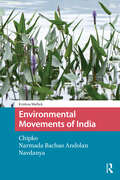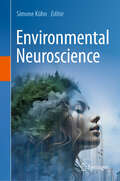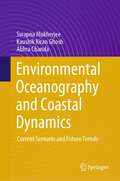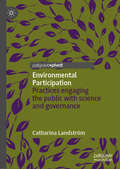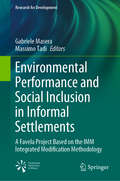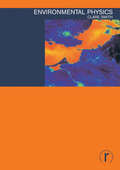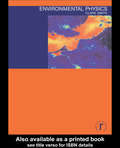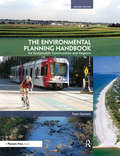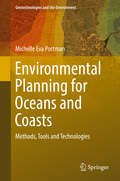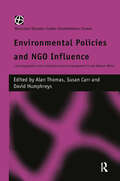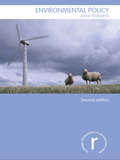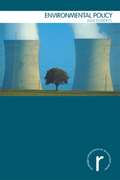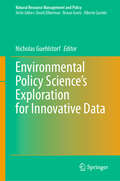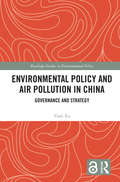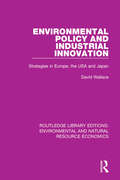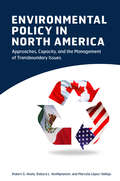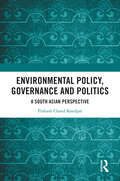- Table View
- List View
Environmental Movements of India: Chipko, Narmada Bachao Andolan, Navdanya (Environment and Society in Asia)
by Krishna MallickIn her detailed retelling of three iconic movements in India, Professor Emerita Krishna Mallick, PhD, gives hope to grassroots activists working toward environmental justice. Each movement deals with a different crisis and affected population: Chipko, famed for tree-hugging women in the Himalayan forest; Narmada, for villagers displaced by a massive dam; and Navdanya, for hundreds of thousands of farmers whose livelihoods were lost to a compact made by the Indian government and neoliberal purveyors of genetically modified organisms (GMOs). Relentlessly researched, Environmental Movements of India: Chipko, Narmada Bachao Andolan, Navdanya presents these movements in a framework that explores Hindu Vedic wisdom, as well as Development Ethics, Global Environment Ethics, Feminist Care Ethics, and the Capability Approach. At a moment when the climate threatens populations who live closest to nature – and depend upon its fodder for heat, its water for life, and its seeds for food – Mallick shows how nonviolent action can give poor people an effective voice.
Environmental Neuroscience
by Simone KühnThis important new book presents an introduction to Environmental Neuroscience, an emerging field devoted to the study of brain-mediated bidirectional relationships between organisms and their physical environments. Environmental Neuroscience offers a novel perspective in the human neurosciences, which have typically focused on the individual isolated from its natural habitat. The book presents the theoretical background of the field, discusses how the environment impacts humans and how humans impact the environment, explores the neuroscience of the built environment, and addresses special populations and presents different methodological approaches. Environmental Neuroscience bringing together the top authorities in the field, will appeal to neuroscientists and to a range of scholars from public health, urban studies, human geography, and architecture who are searching for guidance on what characterizes a health-promoting environment.
Environmental Oceanography and Coastal Dynamics: Current Scenario and Future Trends
by Abhra Chanda Swapna Mukherjee Kaushik Kiran GhoshThis book deals with every aspect of oceanography in detail including various aspects of physical, chemical, geological, and biological discourse. ‘Earth and Planetary Science’ is perhaps the oldest, dynamic, and ever-evolving subject. Oceanography is one of its domains, which has become important in the present date, given the ubiquitous and undeniable climate change that we are experiencing. The subject domain of oceanography encompasses several environmental issues, which need serious attention from the present scientific community. Despite the ocean’s significant role in the collective well-being of the human race, a multitude of anthropogenic activities has drastically polluted and degraded several crucial oceanic ecosystems within a short span. This book aims to present a concise yet succinct introduction to Oceanography as a subject and at the same time highlight the cutting-edge topics of research encompassing marine pollution, coastal processes, and many other associated phenomena. Oceanography is an interdisciplinary emerging subject and students all over the world who come from varied disciplines are pursuing it as higher studies. Long sections are devoted to ocean–atmosphere interaction, tides, waves, and related coastal processes. The book represents a comprehensive idea of human activities bestowing the ocean with particular reference to Indian examples. This book helps to understand marine pollution and the behavior of oil, plastic, and other agents in the light of real-world examples and empirical models. Harnessing electricity from waves and tides is a technological advancement in the field of unconventional energy. The vast resources of the ocean like oil, mineral, methane hydrate, and their proper estimation and exploitation is the topic of discussion in the third part of the book. This book is designated to meet the essential needs of the students studying oceanography and marine science. It may be helpful to professional oceanographers also.
Environmental Oceanography: An Introduction To The Behaviour Of Coastal Waters (CRC Marine Science #11)
by Tom BeerThe second edition of Environmental Oceanography is the first textbook to link the needs of the coastal oceanographer and the environmental practitioner. The ever-increasing human impact on the environment, and particularly on the coastal zone, has led governments to carefully examine the environmental implications of development proposals. This book provides the background needed to undertake coastal oceanographic investigations and sets them in context by incorporating case studies and sample problems based on the author's experience as an environmental consultant.
Environmental Organizations In Modern Germany: Hardy Survivors in the Twentieth Century and Beyond (Monographs in German History #21)
by William T. MarkhamGerman environmental organizations have doggedly pursued environmental protection through difficult times: hyperinflation and war, National Socialist rule, postwar devastation, state socialism in the GDR, and confrontation with the authorities during the 1970s and 1980s. The author recounts the fascinating and sometimes dramatic story of these organizations from their origins at the end of the nineteenth century to the present, not only describing how they reacted to powerful social movements, including the homeland protection and socialist movements in the early years of the twentieth century, the Nazi movement, and the anti-nuclear and new social movements of the 1970s and 1980s, but also examining strategies for survival in periods like the current one, when environmental concerns are not at the top of the national agenda. Previous analyses of environmental organizations have almost invariably viewed them as parts of larger social structures, that is, as components of social movements, as interest groups within a political system, or as contributors to civil society. This book, by contrast, starts from the premise that through the use of theories developed specifically to analyze the behavior of organizations and NGOs we can gain additional insight into why environmental organizations behave as they do.
Environmental Participation: Practices engaging the public with science and governance
by Catharina LandströmThis book introduces environmental participation as a distinct field comprising diverse practices. It presents examples of public participation specifically in environmental science, decision making and expertise. The first chapter introduces the science studies perspective and the key concepts that underpin the argument for approaching such a range of practices as a coherent field. The following three chapters explore a wide range of practical examples of how the public can participate in all three domains. Drawing on her experience with a variety of transdisciplinary projects Landström discusses topics including the coproduction of knowledge about flooding, community involvement with radioactive waste disposal and collaborative water quality modelling. She then goes on to cover citizen science and social movement expertise as environmental participation practices. The concluding chapter reflects on the challenges as well as future opportunities of environmental participation. This book is aimed at readers from a variety of academic and non-academic backgrounds and will be a great interest to social and natural scientists, students and practitioners.
Environmental Performance Auditing in the Public Sector: Enabling Sustainable Development (Routledge Explorations in Environmental Studies)
by Awadhesh PrasadEnvironment and sustainable development challenges are a matter of global concern. Trillions of dollars of mostly public money are invested every year in domestic and international policies and programs to address these challenges. The effectiveness of these policies and programs is critical to environmental sustainability. Performance audits that examine the effectiveness of governmental policies and programs heavily influence their implementation. Despite this, performance auditing in the environment field has received very little academic attention. This book takes a closer look at performance auditing of public sector environmental policies and programs. It examines trends in global environmental performance auditing; and how it is currently practiced drawing on a global survey and case studies from Canada, India and Australia. In doing so, it identifies issues and challenges faced by Supreme Audit Institutions in undertaking these performance audits. This book will be of interest to students, scholars and practitioners of sustainable development, environmental auditing and public sector auditing as well as to donor organisations engaged in these areas.
Environmental Performance and Social Inclusion in Informal Settlements: A Favela Project Based on the IMM Integrated Modification Methodology (Research for Development)
by Gabriele Masera Massimo TadiThis book discusses the potential of a systemic and multidisciplinary design approach to improve urban quality, health, livability, and inclusiveness for people living in informal settlements. In most instances, attempts to address informal settlements lack an adequate assessment of their impact on the wider built environment and implementation of the UN’s Sustainable Development Goals. The Integrated Modification Methodology (IMM), introduced here, offers a systematic, multidisciplinary design tool encompassing several of the aspects that define the environmental performance of urban systems. The book also demonstrates the application of the methodology to an informal settlement, proving its potential to guide systemicurban transformations, also in urban areas lacking formal planning. The case study investigated is in the Rocinha favela in Rio de Janeiro, which ischaracterized by poor water quality, lack of drainage and sanitation systems, and very few green spaces. Based on a rigorous methodology, the process described here can also be applied in similar contexts around the world.
Environmental Personhood: New Trajectories in Law (New Trajectories in Law)
by Francine RochfordThis book examines the increasingly widespread movement to recognise the environment as a legal person. Several countries have now recognized that nature, or parts of nature, have juristic personhood. In this book, the concept of legal personhood and its incidents are interrogated with a view to determining whether this is, or could be, a positive contribution to modern environmental problems. Surveying historical and current positions on the juristic concept of legal personhood, the book engages recent legislation and case law, in order to consider the attempt in several countries to vest personhood in rivers, river basins and ecosystems. Comparing approaches in a range of countries – including New Zealand, India, Ecuador, the United States and Australia, it addresses the methods employed, the purported aims, the mechanisms for enforcement, and the entrenchment of legal protections. Throughout, the book elicits the difficult relationship between an historically anthropocentric idea of personhood and its extension beyond the human; concluding that the attribution of personhood to the environment is an important, but limited, contribution to environmental sustainability. Accessibly written, this book will appeal to scholars, students and others with interests in environmental law, environmental science and public policy, and ecology more generally.
Environmental Philosophy: From Animal Rights to Radical Ecology
by J. Baird Callicott John Clark Michael E. Zimmerman Irene J. Klaver Karen J. WarrenEdited by leading experts in contemporary environmental philosophy, this anthology features the best available selections that cover the full range of positions within this rapidly developing field. Divided into four sections that delve into the vast issues of contemporary Eco-philosophy, the Fourth Edition now includes a section on Continental Environmental Philosophy that explores current topics such as the social construction of nature, and eco-phenomenology. Each section is introduced and edited by a leading philosopher in the field. For professionals with a career within the environmental field including law, politics, conservation, geography, and biology.
Environmental Physics (Routledge Introductions To Environment: Environmental Science Ser.)
by Clare SmithFirst Published in 2002. Environmental Physics is a comprehensive introduction to the physical concepts underlying environmental science. The importance and relevance of physics is emphasised by its application to real environmental problems with a wide range of case studies. Applications included cover energy use and production, global climate, the physics of living things, radioactivity, environmental remote sensing, noise pollution and the physics of the Earth. The book makes the subject accessible to those with little physics background, keeping mathematical treatment straightforward. The text is lively and informative, and is supplemented by numerous illustrations, photos, tables of useful data, and a glossary of key terms.
Environmental Physics (Routledge Introductions to Environment: Environmental Science)
by Clare SmithEnvironmental Physics is a comprehensive introduction to the physical concepts underlying environmental science. The importance and relevance of physics is emphasised by its application to real environmental problems with a wide range of case studies. Applications included cover energy use and production, global climate, the physics of living things, radioactivity, environmental remote sensing, noise pollution and the physics of the Earth. The book makes the subject accessible to those with little physics background, keeping mathematical treatment straightforward. The text is lively and informative, and is supplemented by numerous illustrations, photos, tables of useful data, and a glossary of key terms.
Environmental Planning Handbook
by Tom DanielsEnvironmental protection is a global issue. But most of the action is happening at the local level. How can communities keep their air clean, their water pure, and their people and property safe from climate and environmental hazards? Newly updated, The Environmental Planning Handbook gives local governments, nonprofits, and citizens the guidance they need to create an action plan they can implement now. It’s essential reading for a post-Katrina, post-Sandy world.
Environmental Planning for Oceans and Coasts
by Michelle Eva PortmanThis book informsenvironmental planning professionals, students and those interested in oceansand coasts from an environmental perspective about what is needed for planningand management of these unique environments. It is comprised of twelve chaptersorganized in three parts. Part I highlights the basics tenets of environmentalplanning for oceans and coasts including important concepts from the generalfield of planning and coastal and ocean management (e. g. , hydrography, oceanspolicy and law, geomorphology). Environmental problems inherent within oceansand coasts (such as sea level rise, marine pollution, overdevelopment, etc. )are also addressed, especially those at the land-sea interface. Part II coversthose methodological approaches regularly used by planners working to improveenvironmental quality and conditions of oceans and coasts among them: integrated planning andmanagement, ecosystem services, pollution prevention, and marine spatialplanning. Part III focuses specifically on state-of-the-art tools andtechnologies employed by planners for marine and coastal protection. Theseinclude systematic conservation planning for protected areas, decision supporttools, coastal adaptation techniques and various types of communication, includingvisualization, narration and tools for stakeholder participation. The finalchapter in the book reviews the most important concepts covered throughout bookand emphasizes the important role that environmental planners have to play inthe protection and well-being of oceans and coasts. Michael K. Orbach, of the Nicholas School of the Environment at Duke University, pennedthe book's foreword.
Environmental Policies and NGO Influence: Land Degradation and Sustainable Resource Management in Sub-Saharan Africa (Routledge Research In Global Environmental Change Ser. #No.4)
by Alan Thomas, Susan Carr and David HumphreysThis book examines the conditions under which non-governmental organisations (NGOs) may exert influence on policies to conserve and sustainably use natural resources in sub-Saharan Africa. The book is unique in bringing together NGO campaigners in three African countries with academics specialising in development studies, systems and environmental policy.
Environmental Policies for Air Pollution and Climate Change in the New Europe (Routledge Explorations In Environmental Economics Ser. #28)
by Caterina De LuciaThe interlinked issues of air pollution and energy policies in an enlarged Europe are currently subjects of major interest in economic, environmental, geography and regional sciences. This interest is understandable given the considerable consequences on human health and on climate change issues at not only a European, but a global level. In addition, the recent effects of economic fluctuation and oil prices as well as the actual restructuring of the European energy supply and security market raise a great deal of policy challenges. These issues have become an increasingly relevant concern, as the optimal design of policy by centralised European institutions has come under greater scrutiny. This book presents an integrated approach to recent regulations on air pollution with particular emphasis on transborder air pollution, climate change and energy policies in the new Europe. This integrated vision embraces the extent to which global pollution influences policy decisions at different institutional levels; the magnitude, by virtue of policy simulation analysis, of environmental policy tools (i.e. environmental taxes) on aggregate welfare and transboundary air emissions fluxes in light of the recent enlargement process; the European Trading System and its flexible mechanisms to curb carbon emissions and fulfil the European Union Kyoto Protocol’s commitments; and the developments of the new European energy strategy and its interdependencies across energy requirements, innovation, competitiveness and climate change. The book is primarily aimed at Postgraduates and Postdoctoral research students in economics, environmental economics, environmental sciences, or environmental policy disciplines. However, it should also be of interest to environmental economists, energy policy analysts, members of governmental and non-governmental agencies dealing with environmental policy, climate change or air pollution.
Environmental Policy
by Jane RobertsEvidence of climate change, resource shortages and biodiversity loss is growing in significance year by year. This second edition of Environmental Policy explains how policy can respond and bring about greater sustainability in individual lifestyles, corporate strategies, national policies and international relations. The book discusses the interaction between environmental and human systems, proposing environmental policy as a way to steer human systems to function within environmental constraints. The second edition has been completely updated to reflect advances in scholarship (for example developments in governance theory) and the increasing primacy of climate policy within environmental policy as a whole. Key political, social and economic concepts are used to explain how effective environmental policies can be designed, implemented and evaluated. Environmental problems, the role of human beings in creating them and sustainable development are all introduced. Environmental policy formulation, implementation and evaluation are discussed within three specific contexts: the firm, the nation state and at an international level. The book reviews the relationship of economics, science and technology to environmental policy. It ends by reflecting upon the predicament of humankind in the twenty-first century and the potential of achieve sustainability through the use of the environmental policy ‘toolbox’. Environmental Policy is an accessible text with a multi-disciplinary perspective. Lively case studies drawn from a range of international examples – and completely updated for this second edition – illustrate issues such as climate change, international trade, tourism and human rights. It includes chapter summaries, suggestions for further reading and links to relevant web resources.
Environmental Policy (Routledge Introductions to Environment: Environment and Society Texts)
by Jane RobertsWithin the overall context of sustainable development Environmental Policy discusses the opportunities and constraints that environmental systems place upon the operation of human systems. It suggests environmental policy is a potential way to modify the operation of human systems so that they function within environmental constraints. Key social scientific concepts (political, social and economic) are used to explain the background for the formulation and implementation of environmental policy.Environmental problems, the role of humans in creating them, sustainable development and how this concept relates to environmental policy are all introduced. The book then considers environmental policy formulation, implementation and evaluation, within three specific contexts: the firm, the nation state and at the international level. It also reviews the place of economics, science and technology in environmental policy.Detailed case-studies, drawn from a range of international examples, are used throughout to illustrate issues such as global warming, international trade, tourism and the human rights of indigenous peoples. It is well illustrated and includes end of chapter summaries and further reading.
Environmental Policy Science’s Exploration for Innovative Data (Natural Resource Management and Policy #NA)
by Nicholas GuehlstorfThis edited volume discusses the use of nontraditional data sources in environmental political research and its implications for policymaking. Researchers involved in natural resource investigations and pollution control analysis must be entrepreneurial in finding and utilizing data sets to answer pressing policy questions. To remain relevant, successful researchers must increasingly seek data beyond routine federal program assessments, fragmented local surveys, and limited stakeholder interactions. This volume surveys current environmental research that draws on emerging data sources such as social media and political discourse. It poses critical questions about the potential of creative and innovative analytical approaches, particularly in contexts where policymakers have disregarded objective, evidence-based social science on environmental challenges. By encouraging scholars to adopt new methods, research designs, and data sources, this book offers valuable insights for researchers across the social and environmental sciences.
Environmental Policy and Air Pollution in China: Governance and Strategy (Routledge Studies in Environmental Policy)
by Yuan XuThis book systematically analyzes how and why China has expectedly lost and then surprisingly gained ground in the quest to solve the complicated environmental problem of air pollution over the past two decades. Yuan Xu shines a light on how China’s sulfur dioxide emissions rose quickly in tandem with rapid economic growth but then dropped to a level not seen for at least four decades. Despite this favorable mitigation outcome, Xu details how this stemmed from a litany of policy stumbles within the Chinese context of no democracy and a lack of sound rule of law. Throughout this book, the author examines China’s environmental governance and strategy and how they shape environmental policy. The chapters weave together a goal-centered governance model that China has adopted of centralized goal setting, decentralized goal attainment, decentralized policy making and implementation. Xu concludes that this model provides compelling evidence that China’s worst environmental years reside in the past. This book will be of great interest to students and scholars of Chinese environmental policy and governance, air pollution, climate change and sustainable development, as well as practitioners and policy makers working in these fields.
Environmental Policy and Biodiversity
by R. Edward GrumbineScientists and policymakers must work together if solutions to the biodiversity crisis are to be found. Yet all too often, scientific data are unknown or incomprehensible to policymakers, and political realities are not fully appreciated by scientists.Environmental Policy and Biodiversity addresses that problem by presenting both an overview of important concepts in the field of conservation biology and an examination of the strengths and limitations of the policymaking process. Topics covered include: the ethical and scientific bases of conservation biology the effectiveness of existing environmental policy in protecting biodiversity case studies from California, the Great Lakes region, southern Appalachia, and the Florida panhandle an examination of overall environmental policy goals and processes Featuring provocative and clearly argued essays from a range of disciplines, Environmental Policy and Biodiversity provides resource professionals with valuable insight into conservation issues, and can serve as a useful tool in both graduate and undergraduate courses in conservation biology and environmental policy.
Environmental Policy and Industrial Innovation: Strategies in Europe, the USA and Japan (Routledge Library Editions: Environmental and Natural Resource Economics)
by David WallaceThis book, originally published in 1995, examines the evolution of environmental policy in 6 OECD countries. Through numerous examples, it contrasts the widely-varying political and regulatory styles and their consequences for innovation. Two industry-specific case studies provide a transnational perspective on the co-evolution of technology and environmental policy. The book concludes that innovation can be successfully harnessed by setting credible, long-term environmental goals and ensuring that regulatory instruments are grounded in flexibility, dialogue and trust.
Environmental Policy in North America: Approaches, Capacity, And The Management Of Transboundary Issues
by Robert G. Healy Debora L. VanNijnatten Marcela López-VallejoThis comprehensive analysis of key issues in North American environmental policy provides an overview of how the US, Mexico, and Canada differ in their environmental management approaches and capacity levels, and how these differences play into cross-border cooperation on environmental problems. The book offers insights into transboundary cooperation both before and after NAFTA, and presents a framework for making environmental interaction more effective in the future. The book is organized into two parts. The first, more general, section compares the national contexts for environmental management in each country—including economic conditions, sociocultural dynamics, and political decision-making frameworks— and shows how these have led to variations in policy approaches and levels of capacity. The authors argue that effective environmental governance in North America depends on the ability of transboundary institutions to address and mediate these differences. The book's second section illustrates this argument, using four case studies of environmental management in North America: biodiversity and protected areas, air pollution (smog); greenhouse gas reduction, and genetically modified crops.
Environmental Policy in the EU: Actors, Institutions and Processes
by Andrew Jordan Viviane GraveyThe European Union (EU) has a hugely important effect on the way in which environmental policies are framed, designed and implemented in many parts of the world, but especially Europe. The new edition of this leading textbook provides a state-of-the-art analysis of the EU’s environmental policies. Comprising five parts, Environmental Policy in the EU covers the rapidly changing context in which EU environmental policies are made, the key actors who interact to co-produce them and the most salient dynamics of policy making, ranging from agenda setting and decision making, through to implementation and evaluation. Written by leading international experts, individual chapters examine how the EU is responding to a multitude of different challenges, including biodiversity loss, climate change, energy insecurity, and water and air pollution. They tease out the different ways in which the EU’s policies on these topics co-evolve with national and international environmental policies. In this systematically updated fourth edition, a wider array of learning features are employed to ensure that readers fully understand how EU environmental policies have developed over the last 50 years and how they are currently adapting to the rapidly evolving challenges of the twenty-first century, including the COVID-19 pandemic. It is an essential resource for undergraduate and postgraduate students studying environmental policy and politics, climate change, environmental law and EU politics more broadly.
Environmental Policy, Governance and Politics: A South Asian Perspective
by Prakash Chand KandpalThis book traces the development-environment discourse in India and examines the multi-layered interaction between society and nature in the light of the role of the state, judiciary and the civil society. Through an array of perspectives, the volume challenges the conventional approach to understanding the environmental politics in South Asia without considering the role of the civil society and other informal actors, which has radically altered the conventional articulation of the phenomenon.The volume underlines distinct structural characteristics of developmental politics in India and the social concerns and challenges which come in the way of environmental policy and governance in India. It is a meaningful intervention in unearthing significant socio-political and economic processes which are critical to the environmental governance in India. The book will not only be helpful in studying the state of policy, administration and politics of environmental discourse in India, but also guide the policymakers to explore the sustainable ways of environmental governance in South Asia.Insightful and lucid, this book will be useful to the students, researchers and faculty working in the field of political science, public administration, public policy, political sociology, political economy and governance studies. It will also be an invaluable and interesting reading for those interested in South Asian studies.
